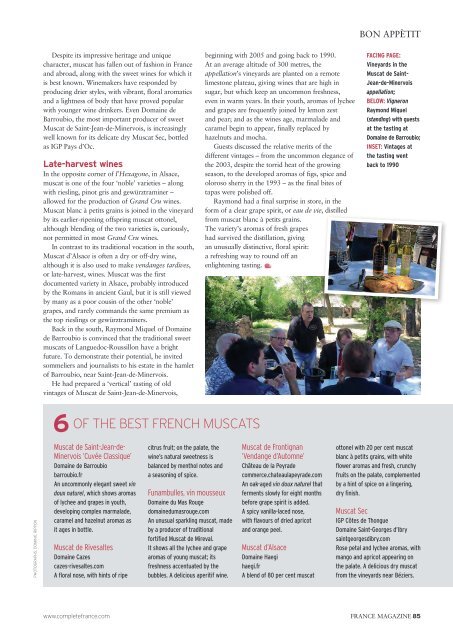You also want an ePaper? Increase the reach of your titles
YUMPU automatically turns print PDFs into web optimized ePapers that Google loves.
BON APPÈTIT<br />
PHOTOGRAPHS: DOMINIC RIPPON<br />
Despite its impressive heritage and unique<br />
character, muscat has fallen out of fashion in <strong>France</strong><br />
and abroad, along with the sweet wines for which it<br />
is best known. Winemakers have responded by<br />
producing drier styles, with vibrant, floral aromatics<br />
and a lightness of body that have proved popular<br />
with younger wine drinkers. Even Domaine de<br />
Barroubio, the most important producer of sweet<br />
Muscat de Saint-Jean-de-Minervois, is increasingly<br />
well known for its delicate dry Muscat Sec, bottled<br />
as IGP Pays d’Oc.<br />
Late-harvest wines<br />
In the opposite corner of l’Hexagone, in Alsace,<br />
muscat is one of the four ‘noble’ varieties – along<br />
with riesling, pinot gris and gewürztraminer –<br />
allowed for the production of Grand Cru wines.<br />
Muscat blanc à petits grains is joined in the vineyard<br />
by its earlier-ripening offspring muscat ottonel,<br />
although blending of the two varieties is, curiously,<br />
not permitted in most Grand Cru wines.<br />
In contrast to its traditional vocation in the south,<br />
Muscat d’Alsace is often a dry or off-dry wine,<br />
although it is also used to make vendanges tardives,<br />
or late-harvest, wines. Muscat was the first<br />
documented variety in Alsace, probably introduced<br />
by the Romans in ancient Gaul, but it is still viewed<br />
by many as a poor cousin of the other ‘noble’<br />
grapes, and rarely commands the same premium as<br />
the top rieslings or gewürztraminers.<br />
Back in the south, Raymond Miquel of Domaine<br />
de Barroubio is convinced that the traditional sweet<br />
muscats of Languedoc-Roussillon have a bright<br />
future. To demonstrate their potential, he invited<br />
sommeliers and journalists to his estate in the hamlet<br />
of Barroubio, near Saint-Jean-de-Minervois.<br />
He had prepared a ‘vertical’ tasting of old<br />
vintages of Muscat de Saint-Jean-de-Minervois,<br />
6<br />
OF THE BEST FRENCH MUSCATS<br />
Muscat de Saint-Jean-de-<br />
Minervois ‘Cuvée Classique’<br />
Domaine de Barroubio<br />
barroubio.fr<br />
An uncommonly elegant sweet vin<br />
doux naturel, which shows aromas<br />
of lychee and grapes in youth,<br />
developing complex marmalade,<br />
caramel and hazelnut aromas as<br />
it ages in bottle.<br />
Muscat de Rivesaltes<br />
Domaine Cazes<br />
cazes-rivesaltes.com<br />
A floral nose, with hints of ripe<br />
citrus fruit; on the palate, the<br />
wine’s natural sweetness is<br />
balanced by menthol notes and<br />
a seasoning of spice.<br />
Funambulles, vin mousseux<br />
Domaine du Mas Rouge<br />
domainedumasrouge.com<br />
An unusual sparkling muscat, made<br />
by a producer of traditional<br />
fortified Muscat de Mireval.<br />
It shows all the lychee and grape<br />
aromas of young muscat; its<br />
freshness accentuated by the<br />
bubbles. A delicious aperitif wine.<br />
beginning with 2005 and going back to 1990.<br />
At an average altitude of 300 metres, the<br />
appellation’s vineyards are planted on a remote<br />
limestone plateau, giving wines that are high in<br />
sugar, but which keep an uncommon freshness,<br />
even in warm years. In their youth, aromas of lychee<br />
and grapes are frequently joined by lemon zest<br />
and pear; and as the wines age, marmalade and<br />
caramel begin to appear, finally replaced by<br />
hazelnuts and mocha.<br />
Guests discussed the relative merits of the<br />
different vintages – from the uncommon elegance of<br />
the 2003, despite the torrid heat of the growing<br />
season, to the developed aromas of figs, spice and<br />
oloroso sherry in the 1993 – as the final bites of<br />
tapas were polished off.<br />
Raymond had a final surprise in store, in the<br />
form of a clear grape spirit, or eau de vie, distilled<br />
from muscat blanc à petits grains.<br />
The variety’s aromas of fresh grapes<br />
had survived the distillation, giving<br />
an unusually distinctive, floral spirit:<br />
a refreshing way to round off an<br />
enlightening tasting.<br />
Muscat de Frontignan<br />
‘Vendange d’Automne’<br />
Château de la Peyrade<br />
commerce.chateaulapeyrade.com<br />
An oak-aged vin doux naturel that<br />
ferments slowly for eight months<br />
before grape spirit is added.<br />
A spicy vanilla-laced nose,<br />
with flavours of dried apricot<br />
and orange peel.<br />
Muscat d’Alsace<br />
Domaine Haegi<br />
haegi.fr<br />
A blend of 80 per cent muscat<br />
FACING PAGE:<br />
Vineyards in the<br />
Muscat de Saint-<br />
Jean-de-Minervois<br />
appellation;<br />
BELOW: Vigneron<br />
Raymond Miquel<br />
(standing) with guests<br />
at the tasting at<br />
Domaine de Barroubio;<br />
INSET: Vintages at<br />
the tasting went<br />
back to 1990<br />
ottonel with 20 per cent muscat<br />
blanc à petits grains, with white<br />
flower aromas and fresh, crunchy<br />
fruits on the palate, complemented<br />
by a hint of spice on a lingering,<br />
dry finish.<br />
Muscat Sec<br />
IGP Côtes de Thongue<br />
Domaine Saint-Georges d’Ibry<br />
saintgeorgesdibry.com<br />
Rose petal and lychee aromas, with<br />
mango and apricot appearing on<br />
the palate. A delicious dry muscat<br />
from the vineyards near Béziers.<br />
www.completefrance.com FRANCE MAGAZINE 85






